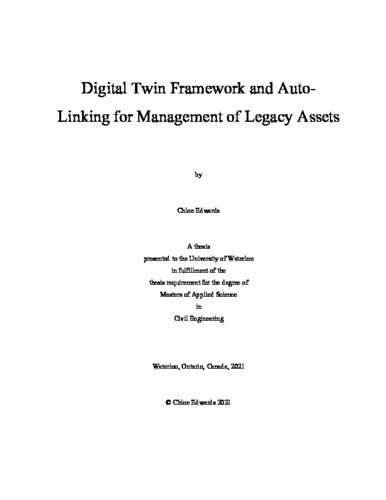UWSpace will be migrating to a new version of its software from July 29th to August 1st. UWSpace will be offline for all UW community members during this time.
Digital Twin Framework and Auto-Linking for Management of Legacy Assets
| dc.contributor.author | Edwards, Chloe | |
| dc.date.accessioned | 2021-04-30 15:33:19 (GMT) | |
| dc.date.available | 2021-04-30 15:33:19 (GMT) | |
| dc.date.issued | 2021-04-30 | |
| dc.date.submitted | 2021-04-05 | |
| dc.identifier.uri | http://hdl.handle.net/10012/16924 | |
| dc.description.abstract | The integration of Digital Twins (DTs) for facility and asset management is becoming increasingly common with the advancement of sensor and modelling technology. A digital twin is defined as a responsive and virtual representation of a physical system or sub-system. While traditionally used at the design stage, there are many benefits to incorporating this technology during operation and maintenance of assets. The application area examined in this thesis relates to Nuclear Power Plant (NPP) facilities with focus on legacy assets. Integration of DTs for facility management (FM) of NPP facilities should improve the efficiency of many processes involved in operations and maintenance of assets. DTs are also advantageous in this application due to their use of virtual representation that can be used for training, scenario modelling, and problem solving with minimal asset down time. To streamline the integration of DTs into current FM standard procedures, the development of a comprehensive DT framework that defines levels of DT development within each NPP subsystem, identifies workflows, and details support documents is required. This thesis aims to develop a DT framework that can be applied to varying levels of legacy assets within an NPP. The framework will guide operators and engineers through the decision-making process that is involved when implementing DTs. The presented DT framework incorporates a layered approach to demonstrate the connections between the physical environment and the virtual digital twin. The underlying levels include perception, communication, and action, each of which represent individual processes that contribute to a functional virtual model. This DT framework uses imagery, 3D scanning, operational data, and asset management software in an organized manner to streamline information integration for digital twin construction. Most of the technology and software included in the framework are commonly used in current practices, which reduces the initial cost and training investment. Since the DT framework presented was specifically developed for NPP FM application, the levels of DT were redefined to accommodate existing NPP FM practices. The support documents and workflows were also adapted according to current practices to simplify the employment of this technology. Implementing DTs within the presented application of a legacy NPP requires a high level of effort that includes digitizing records, creating models of equipment and processes, and linking these digital representations in a functional way within the overall framework. Some of this effort can be automated to improve overall efficiency and reduce time efforts. Auto-linking was developed as a tool that automates steps in the process of identifying physical asset labels within an image and 3D scan of a space within the facility including multiple physical assets such as mechanical, electrical, plumbing equipment, valves, instruments and other related assets. Those asset labels, the information they contain, and the 3D point cloud segments and images related to each tag’s asset must be linked to their respective asset’s information in an asset database that is used for NPP asset management. The 3D point cloud segments, images, and digital database serve as part of the foundation for the NPP DT being constructed within the framework presented. The Auto-linking algorithm uses a deep-learning based approach to object (tag) detection, employs optical character recognition (OCR) to read the asset tag’s unique identifier, then sorts this information into a format that directly relates it, via the asset database, to each 3D point cloud of each scene in which the asset exists. Through Auto-linking, the procedure of labelling legacy assets throughout the facility and documenting existing assets for a digital database is accelerated compared to the current manual procedures. This thesis identifies the challenges faced in FM for NPP facilities and legacy assets and demonstrates how and where DTs could be implemented for improved efficiency. The primary contributions of this thesis include the framework and support tools that can be used for some tasks required for implementing DTs for NPP FM, as well as the Auto-linking algorithm for automated asset management database development or enrichment. While these tools were developed specifically for NPP application, other application areas and adaptation for future work is also highlighted throughout the thesis. | en |
| dc.language.iso | en | en |
| dc.publisher | University of Waterloo | en |
| dc.subject | digital twins | en |
| dc.subject | facility management | en |
| dc.subject | asset management | en |
| dc.subject | deep learning | en |
| dc.subject | nuclear power plant facility management | en |
| dc.subject | object detection | en |
| dc.subject | digital twin framework | en |
| dc.title | Digital Twin Framework and Auto-Linking for Management of Legacy Assets | en |
| dc.type | Master Thesis | en |
| dc.pending | false | |
| uws-etd.degree.department | Civil and Environmental Engineering | en |
| uws-etd.degree.discipline | Civil Engineering | en |
| uws-etd.degree.grantor | University of Waterloo | en |
| uws-etd.degree | Master of Applied Science | en |
| uws-etd.embargo.terms | 0 | en |
| uws.contributor.advisor | Haas, Carl | |
| uws.contributor.affiliation1 | Faculty of Engineering | en |
| uws.published.city | Waterloo | en |
| uws.published.country | Canada | en |
| uws.published.province | Ontario | en |
| uws.typeOfResource | Text | en |
| uws.peerReviewStatus | Unreviewed | en |
| uws.scholarLevel | Graduate | en |

